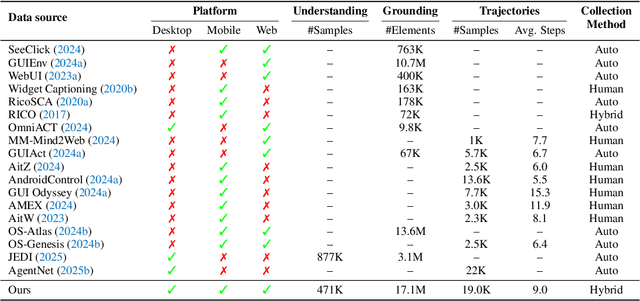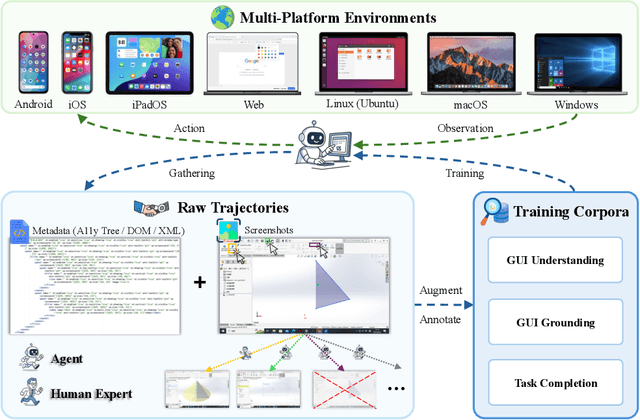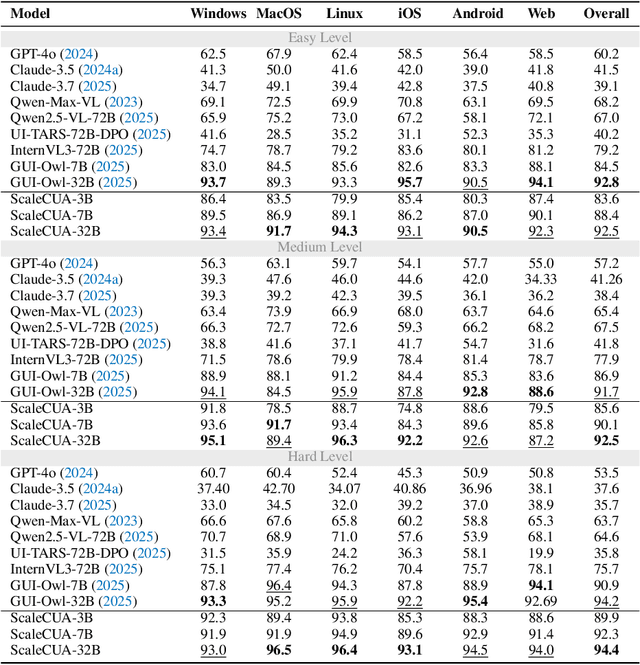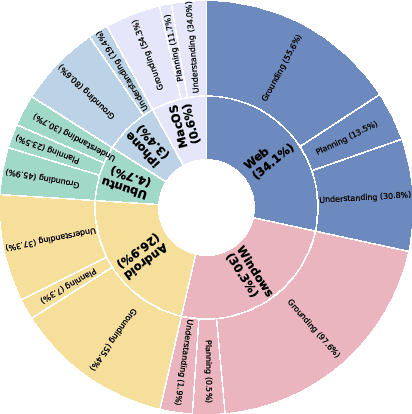Bowen Yang
Charles
ScaleCUA: Scaling Open-Source Computer Use Agents with Cross-Platform Data
Sep 18, 2025



Abstract:Vision-Language Models (VLMs) have enabled computer use agents (CUAs) that operate GUIs autonomously, showing great potential, yet progress is limited by the lack of large-scale, open-source computer use data and foundation models. In this work, we introduce ScaleCUA, a step toward scaling open-source CUAs. It offers a large-scale dataset spanning 6 operating systems and 3 task domains, built via a closed-loop pipeline uniting automated agents with human experts. Trained on this scaled-up data, ScaleCUA can operate seamlessly across platforms. Specifically, it delivers strong gains over baselines (+26.6 on WebArena-Lite-v2, +10.7 on ScreenSpot-Pro) and sets new state-of-the-art results (94.4% on MMBench-GUI L1-Hard, 60.6% on OSWorld-G, 47.4% on WebArena-Lite-v2). These findings underscore the power of data-driven scaling for general-purpose computer use agents. We will release data, models, and code to advance future research: https://github.com/OpenGVLab/ScaleCUA.
OmniEVA: Embodied Versatile Planner via Task-Adaptive 3D-Grounded and Embodiment-aware Reasoning
Sep 11, 2025Abstract:Recent advances in multimodal large language models (MLLMs) have opened new opportunities for embodied intelligence, enabling multimodal understanding, reasoning, and interaction, as well as continuous spatial decision-making. Nevertheless, current MLLM-based embodied systems face two critical limitations. First, Geometric Adaptability Gap: models trained solely on 2D inputs or with hard-coded 3D geometry injection suffer from either insufficient spatial information or restricted 2D generalization, leading to poor adaptability across tasks with diverse spatial demands. Second, Embodiment Constraint Gap: prior work often neglects the physical constraints and capacities of real robots, resulting in task plans that are theoretically valid but practically infeasible.To address these gaps, we introduce OmniEVA -- an embodied versatile planner that enables advanced embodied reasoning and task planning through two pivotal innovations: (1) a Task-Adaptive 3D Grounding mechanism, which introduces a gated router to perform explicit selective regulation of 3D fusion based on contextual requirements, enabling context-aware 3D grounding for diverse embodied tasks. (2) an Embodiment-Aware Reasoning framework that jointly incorporates task goals and embodiment constraints into the reasoning loop, resulting in planning decisions that are both goal-directed and executable. Extensive experimental results demonstrate that OmniEVA not only achieves state-of-the-art general embodied reasoning performance, but also exhibits a strong ability across a wide range of downstream scenarios. Evaluations of a suite of proposed embodied benchmarks, including both primitive and composite tasks, confirm its robust and versatile planning capabilities. Project page: https://omnieva.github.io
InternVL3.5: Advancing Open-Source Multimodal Models in Versatility, Reasoning, and Efficiency
Aug 25, 2025Abstract:We introduce InternVL 3.5, a new family of open-source multimodal models that significantly advances versatility, reasoning capability, and inference efficiency along the InternVL series. A key innovation is the Cascade Reinforcement Learning (Cascade RL) framework, which enhances reasoning through a two-stage process: offline RL for stable convergence and online RL for refined alignment. This coarse-to-fine training strategy leads to substantial improvements on downstream reasoning tasks, e.g., MMMU and MathVista. To optimize efficiency, we propose a Visual Resolution Router (ViR) that dynamically adjusts the resolution of visual tokens without compromising performance. Coupled with ViR, our Decoupled Vision-Language Deployment (DvD) strategy separates the vision encoder and language model across different GPUs, effectively balancing computational load. These contributions collectively enable InternVL3.5 to achieve up to a +16.0\% gain in overall reasoning performance and a 4.05$\times$ inference speedup compared to its predecessor, i.e., InternVL3. In addition, InternVL3.5 supports novel capabilities such as GUI interaction and embodied agency. Notably, our largest model, i.e., InternVL3.5-241B-A28B, attains state-of-the-art results among open-source MLLMs across general multimodal, reasoning, text, and agentic tasks -- narrowing the performance gap with leading commercial models like GPT-5. All models and code are publicly released.
MoCHA: Advanced Vision-Language Reasoning with MoE Connector and Hierarchical Group Attention
Jul 30, 2025Abstract:Vision large language models (VLLMs) are focusing primarily on handling complex and fine-grained visual information by incorporating advanced vision encoders and scaling up visual models. However, these approaches face high training and inference costs, as well as challenges in extracting visual details, effectively bridging across modalities. In this work, we propose a novel visual framework, MoCHA, to address these issues. Our framework integrates four vision backbones (i.e., CLIP, SigLIP, DINOv2 and ConvNeXt) to extract complementary visual features and is equipped with a sparse Mixture of Experts Connectors (MoECs) module to dynamically select experts tailored to different visual dimensions. To mitigate redundant or insufficient use of the visual information encoded by the MoECs module, we further design a Hierarchical Group Attention (HGA) with intra- and inter-group operations and an adaptive gating strategy for encoded visual features. We train MoCHA on two mainstream LLMs (e.g., Phi2-2.7B and Vicuna-7B) and evaluate their performance across various benchmarks. Notably, MoCHA outperforms state-of-the-art open-weight models on various tasks. For example, compared to CuMo (Mistral-7B), our MoCHA (Phi2-2.7B) presents outstanding abilities to mitigate hallucination by showing improvements of 3.25% in POPE and to follow visual instructions by raising 153 points on MME. Finally, ablation studies further confirm the effectiveness and robustness of the proposed MoECs and HGA in improving the overall performance of MoCHA.
Can GPT tell us why these images are synthesized? Empowering Multimodal Large Language Models for Forensics
Apr 16, 2025Abstract:The rapid development of generative AI facilitates content creation and makes image manipulation easier and more difficult to detect. While multimodal Large Language Models (LLMs) have encoded rich world knowledge, they are not inherently tailored for combating AI-generated Content (AIGC) and struggle to comprehend local forgery details. In this work, we investigate the application of multimodal LLMs in forgery detection. We propose a framework capable of evaluating image authenticity, localizing tampered regions, providing evidence, and tracing generation methods based on semantic tampering clues. Our method demonstrates that the potential of LLMs in forgery analysis can be effectively unlocked through meticulous prompt engineering and the application of few-shot learning techniques. We conduct qualitative and quantitative experiments and show that GPT4V can achieve an accuracy of 92.1% in Autosplice and 86.3% in LaMa, which is competitive with state-of-the-art AIGC detection methods. We further discuss the limitations of multimodal LLMs in such tasks and propose potential improvements.
Command A: An Enterprise-Ready Large Language Model
Apr 01, 2025



Abstract:In this report we describe the development of Command A, a powerful large language model purpose-built to excel at real-world enterprise use cases. Command A is an agent-optimised and multilingual-capable model, with support for 23 languages of global business, and a novel hybrid architecture balancing efficiency with top of the range performance. It offers best-in-class Retrieval Augmented Generation (RAG) capabilities with grounding and tool use to automate sophisticated business processes. These abilities are achieved through a decentralised training approach, including self-refinement algorithms and model merging techniques. We also include results for Command R7B which shares capability and architectural similarities to Command A. Weights for both models have been released for research purposes. This technical report details our original training pipeline and presents an extensive evaluation of our models across a suite of enterprise-relevant tasks and public benchmarks, demonstrating excellent performance and efficiency.
Language Models Can See Better: Visual Contrastive Decoding For LLM Multimodal Reasoning
Feb 17, 2025Abstract:Although Large Language Models (LLMs) excel in reasoning and generation for language tasks, they are not specifically designed for multimodal challenges. Training Multimodal Large Language Models (MLLMs), however, is resource-intensive and constrained by various training limitations. In this paper, we propose the Modular-based Visual Contrastive Decoding (MVCD) framework to move this obstacle. Our framework leverages LLMs' In-Context Learning (ICL) capability and the proposed visual contrastive-example decoding (CED), specifically tailored for this framework, without requiring any additional training. By converting visual signals into text and focusing on contrastive output distributions during decoding, we can highlight the new information introduced by contextual examples, explore their connections, and avoid over-reliance on prior encoded knowledge. MVCD enhances LLMs' visual perception to make it see and reason over the input visuals. To demonstrate MVCD's effectiveness, we conduct experiments with four LLMs across five question answering datasets. Our results not only show consistent improvement in model accuracy but well explain the effective components inside our decoding strategy. Our code will be available at https://github.com/Pbhgit/MVCD.
Rope to Nope and Back Again: A New Hybrid Attention Strategy
Jan 30, 2025



Abstract:Long-context large language models (LLMs) have achieved remarkable advancements, driven by techniques like Rotary Position Embedding (RoPE) (Su et al., 2023) and its extensions (Chen et al., 2023; Liu et al., 2024c; Peng et al., 2023). By adjusting RoPE parameters and incorporating training data with extended contexts, we can train performant models with considerably longer input sequences. However, existing RoPE-based methods exhibit performance limitations when applied to extended context lengths. This paper presents a comprehensive analysis of various attention mechanisms, including RoPE, No Positional Embedding (NoPE), and Query-Key Normalization (QK-Norm), identifying their strengths and shortcomings in long-context modeling. Our investigation identifies distinctive attention patterns in these methods and highlights their impact on long-context performance, providing valuable insights for architectural design. Building on these findings, we propose a novel architectural based on a hybrid attention mechanism that not only surpasses conventional RoPE-based transformer models in long context tasks but also achieves competitive performance on benchmarks requiring shorter context lengths.
Mimicking-Bench: A Benchmark for Generalizable Humanoid-Scene Interaction Learning via Human Mimicking
Dec 23, 2024Abstract:Learning generic skills for humanoid robots interacting with 3D scenes by mimicking human data is a key research challenge with significant implications for robotics and real-world applications. However, existing methodologies and benchmarks are constrained by the use of small-scale, manually collected demonstrations, lacking the general dataset and benchmark support necessary to explore scene geometry generalization effectively. To address this gap, we introduce Mimicking-Bench, the first comprehensive benchmark designed for generalizable humanoid-scene interaction learning through mimicking large-scale human animation references. Mimicking-Bench includes six household full-body humanoid-scene interaction tasks, covering 11K diverse object shapes, along with 20K synthetic and 3K real-world human interaction skill references. We construct a complete humanoid skill learning pipeline and benchmark approaches for motion retargeting, motion tracking, imitation learning, and their various combinations. Extensive experiments highlight the value of human mimicking for skill learning, revealing key challenges and research directions.
Aya Expanse: Combining Research Breakthroughs for a New Multilingual Frontier
Dec 05, 2024



Abstract:We introduce the Aya Expanse model family, a new generation of 8B and 32B parameter multilingual language models, aiming to address the critical challenge of developing highly performant multilingual models that match or surpass the capabilities of monolingual models. By leveraging several years of research at Cohere For AI and Cohere, including advancements in data arbitrage, multilingual preference training, and model merging, Aya Expanse sets a new state-of-the-art in multilingual performance. Our evaluations on the Arena-Hard-Auto dataset, translated into 23 languages, demonstrate that Aya Expanse 8B and 32B outperform leading open-weight models in their respective parameter classes, including Gemma 2, Qwen 2.5, and Llama 3.1, achieving up to a 76.6% win-rate. Notably, Aya Expanse 32B outperforms Llama 3.1 70B, a model with twice as many parameters, achieving a 54.0% win-rate. In this short technical report, we present extended evaluation results for the Aya Expanse model family and release their open-weights, together with a new multilingual evaluation dataset m-ArenaHard.
 Add to Chrome
Add to Chrome Add to Firefox
Add to Firefox Add to Edge
Add to Edge